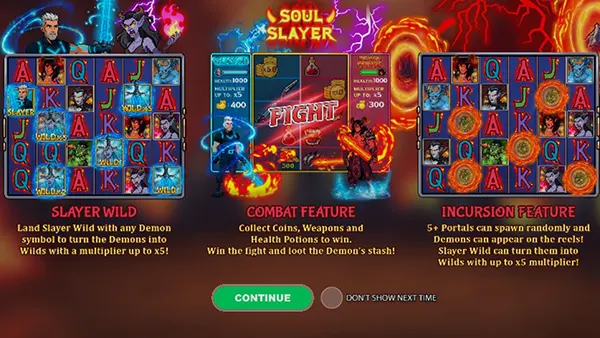
Soul Slayer: A Detailed Review of a Dark High-Volatility Slot with Combat Features
Soul Slayer stands out in 2025 as one of the most complex high-volatility slots built around a combat-driven mechanic. Designed for players who appreciate strategic elements inside a reel-based format, it blends risk multipliers, progressive challenges, and dynamic symbol interactions. This title focuses heavily on tactical choices, pushing users to evaluate danger levels before committing to each spin.
Core Gameplay Structure and High-Volatility Dynamics
The foundation of Soul Slayer revolves around a five-reel grid where symbol combinations activate combat actions rather than traditional animations. The volatility level is intentionally elevated, which means outcomes are rare but significantly larger when they appear. Such a structure appeals to players seeking long-term progression within a risk-reward environment.
The combat mechanic triggers each time a battle symbol lands on specific reels, prompting a simulated clash that alters the spin’s direction. These encounters can remove blockers, add multipliers, or escalate the threat meter. Each change in the threat meter directly influences the reward scale, offering transparency regarding potential outcomes.
Multipliers in this slot do not activate randomly. Instead, they grow as the threat meter advances through defined tiers. Higher tiers introduce more severe virtual opponents, but they also increase the damage multipliers that apply to winning sequences. This structure encourages calculated decision-making rather than relying on simple luck.
Risk Multipliers and Their Strategic Importance
Risk multipliers are one of the primary features that separate Soul Slayer from traditional high-volatility titles. Each spin contributes to a background progression bar that determines which multiplier is currently active. The more aggressive the virtual enemy, the higher the possible payout range for the next victory.
Players must monitor the enemy tier carefully, as advancing too quickly may result in extended periods without wins. However, the boosted multipliers at higher levels may compensate for dry intervals. This system relies on player patience and an understanding of the slot’s reward curve.
The multiplier resets only after a confirmed win, meaning players can deliberately push the risk upward before triggering a potential reward. This makes the experience highly tactical and different from most games where multipliers expire after a feature ends.
Combat Encounters and Symbol Interactions
Every combat encounter is tied to specific symbols that activate unique abilities. For example, a weapon symbol enhances damage dealt during the virtual battle, while a shield symbol softens enemy retaliation effects. These interactions give the game a layered structure, turning each spin into a miniature tactical event.
Some symbols combine to activate advanced combat phases that escalate the threat meter instantly. These phases alter reel layouts, introduce temporary wild elements, and change the behaviour of the multiplier ladder. By doing so, Soul Slayer keeps players engaged through constant variations in its internal mechanics.
Special encounters occur when rare symbols appear simultaneously. These encounters may unlock optional challenges, allowing players to influence the outcome through predetermined choices. While these choices do not grant guaranteed wins, they may adjust multiplier pathways or remove negative modifiers.
Advanced Features and Optional Challenges
Certain advanced challenges allow players to pick between two or three tactical actions, each carrying different probability ranges. These actions might amplify multipliers, bypass lower-tier enemies, or reduce the risk of losing progress. Such selective mechanics introduce a more personalised experience.
The optional challenges also enrich the pacing of the game. They occur infrequently, making their appearance meaningful and impactful. Players who understand the internal balancing of Soul Slayer can use these moments to align the threat meter with favourable multiplier positions.
These features elevate the title beyond a standard spin-and-win structure. By integrating tactical decisions, the experience feels cohesive and grounded rather than dependent solely on random generation.

Technical Aspects and Developer Implementation
The technical construction of Soul Slayer reflects modern slot engineering standards. The game has been developed using optimised rendering pipelines that ensure stable performance on both desktop and mobile devices. Real-time animations during combat moments are processed without unnecessary delays, even on mid-range hardware.
The return-to-player (RTP) percentage typically ranges between 95.8% and 96.3%, depending on the version used by the operator. High volatility paired with mid-range RTP ensures a balanced yet dynamic curve that suits experienced players comfortable with longer gaming cycles.
Security standards follow 2025 certification norms. The title uses regulated randomisation protocols, and every combat outcome is calculated through certified mathematical models. This ensures that the combat system, despite its animated presentation, remains fair and fully transparent according to industry requirements.
User Experience and Interface Design
Interface design prioritises clarity. The threat meter, multiplier ladder, and combat indicators are positioned to ensure visibility without overwhelming the reel layout. All game actions, including symbol clashes, are displayed with minimal distraction from the spin results.
The audio design supports the dark theme but avoids excessive intensity. Subtle cues highlight changes in multiplier tiers or enemy transitions. This aids players in tracking key gameplay elements without needing to study the interface constantly.
The game adapts well to modern touchscreen gestures, enabling fluid navigation across menus and settings. This accessibility makes Soul Slayer suitable for mobile-focused audiences who prefer fast and responsive layouts.
